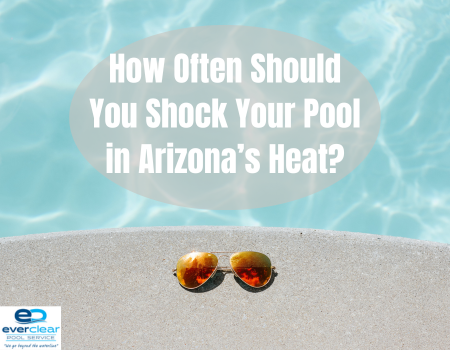Are you wondering how often you should shock your pool? You aren’t alone! Owning a pool in Arizona is both a luxury and a necessity during the blazing summer months. With temperatures often soaring above 100°F, your backyard pool quickly becomes the most valuable spot in your home. But keeping your pool water clean, clear, and safe in the desert heat takes more than just skimming and balancing chemicals. One of the most important maintenance steps — and one that often raises questions — is pool shocking.
If you’ve ever wondered how often you should shock your pool in Arizona’s extreme heat, you’re not alone. The short answer is: more frequently than you might in cooler climates. Let’s explore why that is, how shocking works, and how often you should be doing it to keep your pool in top shape all summer long.
 What Is Pool Shocking?
What Is Pool Shocking?
Shocking a pool means adding a high dose of chlorine or another oxidizing chemical to the water to quickly raise the sanitizer level and kill off contaminants. This includes bacteria, algae, chloramines (the compounds that cause strong chlorine odors and eye irritation), and other organic matter introduced by swimmers, rain, dust storms, and plant debris.
The process helps to reset your pool’s water chemistry, restoring clarity, safety, and that clean, fresh smell you expect from a well-maintained pool.
Why Arizona Heat Makes a Difference
Arizona’s desert climate presents some unique challenges for pool owners:
- High Temperatures: Intense sunlight and high air temperatures cause chlorine to dissipate much faster. UV rays break down free chlorine, reducing its effectiveness in killing bacteria and algae.
- Increased Pool Use: During the hot months, pools in Arizona see more swimmers, meaning more sunscreen, body oils, sweat, and other contaminants entering the water.
- Dust and Debris: Frequent dust storms and dry winds carry fine particles, dirt, and organic matter into pools, increasing the chlorine demand and creating breeding grounds for algae.
All these factors mean chlorine gets used up faster, and organic material builds up more quickly — both of which call for regular pool shocking to maintain water quality.
How Often Should You Shock Your Pool in Arizona?
While the general recommendation for pool shocking is once every 1–2 weeks, Arizona’s extreme conditions often require a more aggressive approach.
Here’s a practical guideline:
- At Least Once a Week During Peak Summer:
When daily temperatures consistently exceed 100°F and your pool is in frequent use, shocking it once a week helps maintain a safe, sanitized environment. - After Heavy Pool Use:
If you’ve hosted a pool party or had a large group swimming, shock your pool immediately afterward to neutralize contaminants introduced by the extra swimmers. - After a Dust Storm or Monsoon:
Arizona’s infamous dust storms (haboobs) and sudden monsoon rains can introduce large amounts of debris and dirt into your pool. It’s a good idea to shock your pool right after these events. - When Chlorine Levels Drop or Water Appears Cloudy:
Test your water regularly, especially during extreme heat. If chlorine levels fall below 1 ppm (parts per million) or if the water looks hazy, it’s time to shock. - At the First Sign of Algae:
If you notice even a slight green, yellow, or black tint along your pool walls or floor, shock immediately before the algae spreads.
How to Shock Your Pool Safely
When shocking your pool, follow these safety tips:
- Choose the right shock product. Calcium hypochlorite is a popular and effective option for most Arizona pools.
- Shock in the evening. Direct sunlight rapidly breaks down chlorine. Adding shock after sunset allows it to work overnight without UV interference.
- Circulate the water. Run your pump and filtration system while shocking and for several hours afterward to evenly distribute chemicals.
- Wait before swimming. Follow product guidelines, typically waiting at least 8–12 hours and ensuring chlorine levels drop back to a safe range (1–3 ppm) before swimming.
- Use protective gear. Wear gloves and safety goggles when handling pool chemicals.
If you cannot handle this yourself, you should engage the services of a professional pool service to do do a good job.
In Arizona’s blistering heat, your pool’s chlorine levels and overall water balance require constant attention. Shocking your pool weekly during peak summer months — and as needed after storms, parties, or visible water issues — is essential to keep your pool water clean, clear, and safe.
Regular testing, proper chemical management, and timely shocking will help you enjoy a sparkling, refreshing pool all season long, even under Arizona’s relentless sun.
